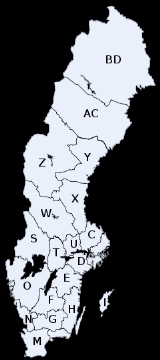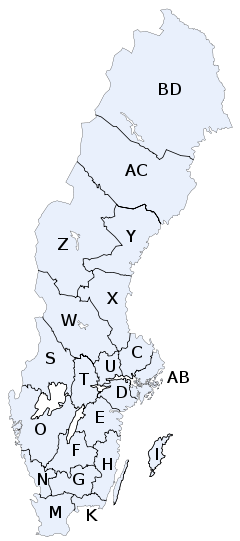
Län
Encyclopedia

Sweden
Sweden , officially the Kingdom of Sweden , is a Nordic country on the Scandinavian Peninsula in Northern Europe. Sweden borders with Norway and Finland and is connected to Denmark by a bridge-tunnel across the Öresund....
and previously in Finland
Finland
Finland , officially the Republic of Finland, is a Nordic country situated in the Fennoscandian region of Northern Europe. It is bordered by Sweden in the west, Norway in the north and Russia in the east, while Estonia lies to its south across the Gulf of Finland.Around 5.4 million people reside...
. The provinces of Finland were abolished on January 1, 2010.
They are also sometimes used in other countries, especially as a translation of the Russian
Russian language
Russian is a Slavic language used primarily in Russia, Belarus, Uzbekistan, Kazakhstan, Tajikistan and Kyrgyzstan. It is an unofficial but widely spoken language in Ukraine, Moldova, Latvia, Turkmenistan and Estonia and, to a lesser extent, the other countries that were once constituent republics...
word oblast
Oblast
Oblast is a type of administrative division in Slavic countries, including some countries of the former Soviet Union. The word "oblast" is a loanword in English, but it is nevertheless often translated as "area", "zone", "province", or "region"...
. During the period when Finland
Grand Duchy of Finland
The Grand Duchy of Finland was the predecessor state of modern Finland. It existed 1809–1917 as part of the Russian Empire and was ruled by the Russian czar as Grand Prince.- History :...
was a part of the Russian Empire
Russian Empire
The Russian Empire was a state that existed from 1721 until the Russian Revolution of 1917. It was the successor to the Tsardom of Russia and the predecessor of the Soviet Union...
(1809-1917), when Russian
Russian language
Russian is a Slavic language used primarily in Russia, Belarus, Uzbekistan, Kazakhstan, Tajikistan and Kyrgyzstan. It is an unofficial but widely spoken language in Ukraine, Moldova, Latvia, Turkmenistan and Estonia and, to a lesser extent, the other countries that were once constituent republics...
was made an official language alongside Swedish, it was synonymous with the word guberniya
Guberniya
A guberniya was a major administrative subdivision of the Russian Empire usually translated as government, governorate, or province. Such administrative division was preserved for sometime upon the collapse of the empire in 1917. A guberniya was ruled by a governor , a word borrowed from Latin ,...
.
The term
The word literally means fief. The usual English languageEnglish language
English is a West Germanic language that arose in the Anglo-Saxon kingdoms of England and spread into what was to become south-east Scotland under the influence of the Anglian medieval kingdom of Northumbria...
terms used are separate for the two countries, where Sweden has chosen to translate the term as "county
Counties of Sweden
The Counties of Sweden are the first level administrative and political subdivisions of Sweden. Sweden is divided into 21 counties. The counties were established in 1634 on Count Axel Oxenstierna's initiative, superseding the historical provinces of Sweden to introduce a modern administration...
" while Finland prefers "province
Provinces of Finland
The state of Finland consisted of six provinces between the years 1997 and 2009. The provincial authority was part of the central government's executive branch, not directly elected. The system was created in 1634, and its makeup was changed drastically in 1997, when the number of the provinces...
".
With a shared administrative tradition spanning centuries, ending only in 1809, this is a separation by convention, rather than by distinction. The term matches reasonably well the British term "county
Counties of the United Kingdom
The counties of the United Kingdom are subnational divisions of the United Kingdom, used for the purposes of administrative, geographical and political demarcation. By the Middle Ages counties had become established as a unit of local government, at least in England. By the early 17th century all...
", but not so well the American term "county
County (United States)
In the United States, a county is a geographic subdivision of a state , usually assigned some governmental authority. The term "county" is used in 48 of the 50 states; Louisiana is divided into parishes and Alaska into boroughs. Parishes and boroughs are called "county-equivalents" by the U.S...
" which is usually much smaller in population, more like Swedish "kommun
Municipalities of Sweden
The municipalities of Sweden are the local government entities of Sweden. The current 290 municipalities are organized into 21 counties...
".
The reason why Sweden has chosen to translate the term to "county" is that in Swedish
Swedish language
Swedish is a North Germanic language, spoken by approximately 10 million people, predominantly in Sweden and parts of Finland, especially along its coast and on the Åland islands. It is largely mutually intelligible with Norwegian and Danish...
and English
English language
English is a West Germanic language that arose in the Anglo-Saxon kingdoms of England and spread into what was to become south-east Scotland under the influence of the Anglian medieval kingdom of Northumbria...
, the word "provins"/"province" has come to mean different things. In the Swedish Empire
Swedish Empire
The Swedish Empire refers to the Kingdom of Sweden between 1561 and 1721 . During this time, Sweden was one of the great European powers. In Swedish, the period is called Stormaktstiden, literally meaning "the Great Power Era"...
, all lands conquered became provinser (provinces); Swedish law, which granted the common people much more freedom and influence than any other European law at the time, was not extended to them, remaining confined to the landskap
Provinces of Sweden
The provinces of Sweden, landskap, are historical, geographical and cultural regions. Sweden has 25 provinces and they have no administrative function, but remain historical legacies and the means of cultural identification....
(in plural) which made up the Swedish-and-Finnish heartland (roughly corresponding to present-day Sweden
Sweden
Sweden , officially the Kingdom of Sweden , is a Nordic country on the Scandinavian Peninsula in Northern Europe. Sweden borders with Norway and Finland and is connected to Denmark by a bridge-tunnel across the Öresund....
and Finland
Finland
Finland , officially the Republic of Finland, is a Nordic country situated in the Fennoscandian region of Northern Europe. It is bordered by Sweden in the west, Norway in the north and Russia in the east, while Estonia lies to its south across the Gulf of Finland.Around 5.4 million people reside...
). Examples of such former Swedish provinser are Estonia
Estonia
Estonia , officially the Republic of Estonia , is a state in the Baltic region of Northern Europe. It is bordered to the north by the Gulf of Finland, to the west by the Baltic Sea, to the south by Latvia , and to the east by Lake Peipsi and the Russian Federation . Across the Baltic Sea lies...
and Swedish Pomerania
Swedish Pomerania
Swedish Pomerania was a Dominion under the Swedish Crown from 1630 to 1815, situated on what is now the Baltic coast of Germany and Poland. Following the Polish War and the Thirty Years' War, Sweden held extensive control over the lands on the southern Baltic coast, including Pomerania and parts...
. Another reason is that in education, Sweden has preferred British English over American English. "County" is a reasonable British English translation of Län.
The län
In Sweden a län is but an arm of the executive power of the national government, and has no autonomy nor legislative power. The län subdivision does not always match the traditional provinces, which are called landskapLandskap
Landskap is common Scandinavian word which means landscape or province and can refer to:*Districts of Norway, the historical provinces of Norway*Provinces of Sweden, the historical provinces of Sweden and Finland...
(singular and plural) in Swedish
Swedish language
Swedish is a North Germanic language, spoken by approximately 10 million people, predominantly in Sweden and parts of Finland, especially along its coast and on the Åland islands. It is largely mutually intelligible with Norwegian and Danish...
(including Swedish-speaking Finland) and maakunnat (singular maakunta) in Finnish
Finnish language
Finnish is the language spoken by the majority of the population in Finland Primarily for use by restaurant menus and by ethnic Finns outside Finland. It is one of the two official languages of Finland and an official minority language in Sweden. In Sweden, both standard Finnish and Meänkieli, a...
. The same situation existed in Finland until län/lääni were abolished in 2010.
- Counties of SwedenCounties of SwedenThe Counties of Sweden are the first level administrative and political subdivisions of Sweden. Sweden is divided into 21 counties. The counties were established in 1634 on Count Axel Oxenstierna's initiative, superseding the historical provinces of Sweden to introduce a modern administration...
— (Sveriges län) - Provinces of FinlandProvinces of FinlandThe state of Finland consisted of six provinces between the years 1997 and 2009. The provincial authority was part of the central government's executive branch, not directly elected. The system was created in 1634, and its makeup was changed drastically in 1997, when the number of the provinces...
(abolished 2010) — (Suomen läänit / Finlands län)
Historically the term guberniya
Guberniya
A guberniya was a major administrative subdivision of the Russian Empire usually translated as government, governorate, or province. Such administrative division was preserved for sometime upon the collapse of the empire in 1917. A guberniya was ruled by a governor , a word borrowed from Latin ,...
was used for the län/lääni in the Grand Duchy of Finland
Grand Duchy of Finland
The Grand Duchy of Finland was the predecessor state of modern Finland. It existed 1809–1917 as part of the Russian Empire and was ruled by the Russian czar as Grand Prince.- History :...
as a part of Russia from 1809 to 1917. See Governorates of the Grand Duchy of Finland.
The landsting
In every Swedish län (except Gotland) there is a landstingLandsting
Landsting can mean*Thing - the supreme assembly of a land in Scandinavia, during Viking and mediaeval times*The Parliament of Greenland.*Landstinget - one of the two houses of the Danish parliament between 1849 and 1953...
. This is a locally elected assembly, which collects tax and has responsibility for a number of services to the population. The main responsibility is for hospitals.
The landshövding
The governor has the title landshövding (Swedish) (previously maaherra in Finnish). He or she is appointed by the government, and presides over the länsstyrelse (Swedish ; previously lääninhallitus in Finnish) - translated as "County Administrative Board"County Administrative Boards of Sweden
A County Administrative Board is a Government appointed board of a County in Sweden. It is led by a Governor or Landshövding appointed for a term of six years and the list of succession, in most cases, stretches back to 1634 when the counties were created...
. The governor's office is administrative by nature, which is also hinted at by the now obsolete title Konungens befallningshavande - "the King's Deputy" - and traditionally used as an honourable post for politicians to conclude their careers. In Finland the governor/landshövding/maaherra positions were cancelled in 2010. In opposite to countries like USA, the governor in Sweden is not elected by the people, but represents the central government.

